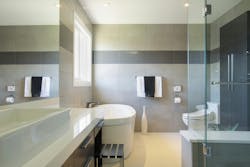K&B Design: Planning Tips from Bathroom Pros
Planning a bathroom requires knowledge about many concepts related to people and their houses. The designer must draw on information about plumbing and electrical systems, bathroom fixtures, finishes, and the people who will be using the space.
The NKBA Bathroom Planning Guidelines with Access Standards includes several recommendations that deal with the general layout and design of the bathroom. These include the entry, ceiling height, and circulation spaces within the bathroom.
There are many different ways to approach designing bathrooms. The NKBA Bath Planning book focuses on the center concept. A center is an area where a particular task or function occurs. The user, space, fixtures, and other components are all analyzed in order to design a center for a particular task. The basic tasks and corresponding centers in the bathroom are grooming, bathing/showering, and toileting.
As you examine the space of an existing bathroom or the plans for a new one, there are several general things that should be assessed. Not only are the dimensions of the space important but the form of the space needs to be considered.
How will the space join to adjacent rooms or areas? Are there other openings, such as windows? Is the space a basic rectangle shape or are there curves or angles? How will the user(s) move about the space?
Bathroom entry
One of the first decisions for the design is how to get into the bathroom. Door placement can make a real difference in the available space and in the circulation and sight lines to adjacent rooms. If a major remodeling or new construction is taking place, look carefully at the entry and examine all possibilities for its location.
In more modest remodeling projects, there may not be space or budget to allow for a change in door location. It is recommended the entry to the bathroom have a 32-inch clear opening between the door jambs. This can be accomplished by specifying at least a 2-foot, 10-inch door. While this is larger than what has been typical in the past, consumers are requesting this enhancement.
Not only will it make the bathroom more spacious, it will accommodate larger people, some people with assistive devices, and a large tub or shower installation.
If a doorframe of a remodeled bathroom cannot be modified, NKBA allows a door as small as 2 feet, but it will be difficult for many people to use and will not meet basic visit-ability or access standards. It will allow you to get a 21-inch-deep vanity into the room, but not larger cabinetry or fixtures.
In many cases, a 3-foot door is preferred as it provides 34 inches of clear opening for even greater clearance. When the clear space of a door is less than desired, a swing-clear hinge may be used to gain clear passage by moving the door out of the opening. For a person using a wheelchair or mobility aid, a minimum of 18 inches on the pull side of the door is recommended to allow room for the person to maneuver around the swing of the door. Actual clearances are impacted by a person’s approach and the door configuration.
The IRC requires that entry doors and other cabinet doors not interfere with activity centers and circulation in the bathroom. A poorly placed door could interfere with getting into the bathroom or shower to help someone who has fallen. An improperly placed doorstop or doorknob could interfere with a passage for a person with a vision or mobility impairment.
In private bathrooms, you may consider café doors, which are two doors hinged to the opposite door frames, meeting in the middle, thus reducing the amount of room needed for door clearances. The doors swing in both directions and close automatically once a person has passed beyond the door swing. Others may not need or want a door at all. A single user and certain family members may not feel the need for a full door to assure privacy.
Proper bathroom planning
The bathroom is an important part of any home and often a bathroom is located in both private and social areas. All bathrooms are composed of a combination of centers where the major activities of the bathroom occur: grooming, bathing/showering, and toileting. Planning a bathroom using the center concept encourages the designer to examine and use the NKBA Bathroom Planning Guidelines and Access Standards for each area.
The Planning Guidelines are based on human factors and the 2012 International Residential Code. The Bathroom Access Standards are based on the 2009 International Code Council ANSI 1.117.
Budget, time, and space restrictions will influence how you incorporate the guidelines within the parameters of each bathroom design. Of course, local building codes will have to be met and should be referenced during the design process. The Bathroom Planning Guidelines incorporate several building code requirements that must be followed when planning a bathroom: for instance, minimum space clearances, and requirements related to windows, doors, and access panels.
Beyond building codes, the Bathroom Planning Guidelines provide recommendations for space clearances at the entry and at each fixture. Universal design recommendations are also incorporated.
Recommendations for slip-resistant flooring, rounded counter edges, grab bars at bathing and shower fixtures, and seating in the shower are helpful features that will make the bathroom safer.
Remember that infrastructure requirements also must be considered. There are also decisions related to mechanical systems. Lighting, ventilation, heat, and placement of receptacles are important to consider when you start to design a space. PR
--
This article is excerpted from the NKBA Professional Resource Library volumes: Kitchen & Bath Residential Construction and Systems by Jerry Germer; Kitchen Planning, Second Edition by Julia Beamish, PhD, CKD, Kathleen Parrott, PhD, CKE, JoAnn Emmel, PhD, and Mary Jo Peterson, CKD, CBD, CAPS, CAASH. Copyright: 2013 National Kitchen & Bath Association; published by John Wiley & Sons, Inc. This material is reproduced with the permission of John Wiley & Sons Inc.
